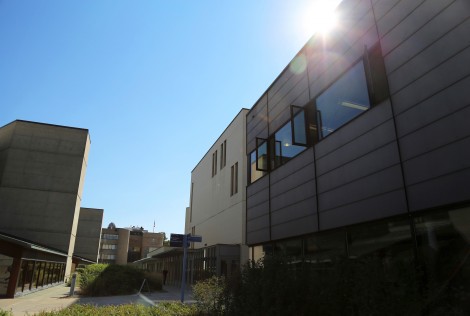[dropcap]I[/dropcap]t’s easy to feel lost at U of T. Fortunately, nestled in UTSC lies the Doris McCarthy gallery. It hosts a variety of exhibits that confront and challenge the everyday understanding of society, seeking to make sense of the incomprehensible, much like university attempts to do.
As an art-obsessed student, I believe that U of T’s most important art exhibition building is the Doris McCarthy Gallery (DMG). Opened in 2004 and named after famous Canadian artist Doris McCarthy — known for her vivid arctic landscape paintings — it presents students with a visual dose of education beyond the tradition of textbooks and lectures.
My first of several transformative visits to the DMG took place in late fall of last year and was inspired by a tutorial. The objective was to find and utilize art works as the main subject for the final essay of a course. Complex Social Change was the first exhibition where I distinctively remember gazing with puzzled, folded arms, unsure if I really understood what I was looking at.
The exhibition was curated by Josephine Mills and became more than just the subject of an essay. The exhibit displayed domestic objects like pillows in unexpected ways and featured upside down brooms spelling out ‘Free Pussy Riot.’
It sought to address the global issue of gender inequality in a modern context. The late Toronto artist Wendy Coburn’s sculptures were also on display at the DMG. Made of a silver turkey baster, bronze toaster oven, and white acorn each in their own glass case, they attempted to challenge conventional knowledge and perspectives. What seemed obvious still needed further explanation from our professor and the gallery assistant to understand Coburn’s larger Queer references and gain insight into a poignant world.
In addition to the eye-opening and informative Complex Social Change exhibit, the Material Girls exhibit last February made a lasting impression on me and the way I understood art.
Material Girls was co-curated by three women: Regina’s Dunlop Art Director Jennifer Matotek, assistant curator Blair Fornwald and Curator of Education and Community Outreach Wendy Peart. The exhibit was innovative with its immersive design, tones of inclusion and feminism, and unprecedented content.
Matotek described the premise of an all-female exhibition as something that “somehow feels radical.” She explained, “We selected artists and art works that were relevant to our theme and concept — the idea of female artists taking up space who work in compelling ways with materials.”
The Complex Social Change and Material Girls exhibits speak to the importance of the DMG. It is an art gallery that presents exhibits as a forum to challenge the status quo.
Navigating the DMG was initially overwhelming, just like my first few weeks at U of T. Every new exhibition provides information to digest and many concepts, meanings, and interpretations.
You may not grasp everything until you look at it from a different angle or with the help of a knowledgeable professor or gallery assistant, but after a year, I understand the importance of looking around and seeing new ideas. That’s the best part about the Gallery and about attending U of T.




